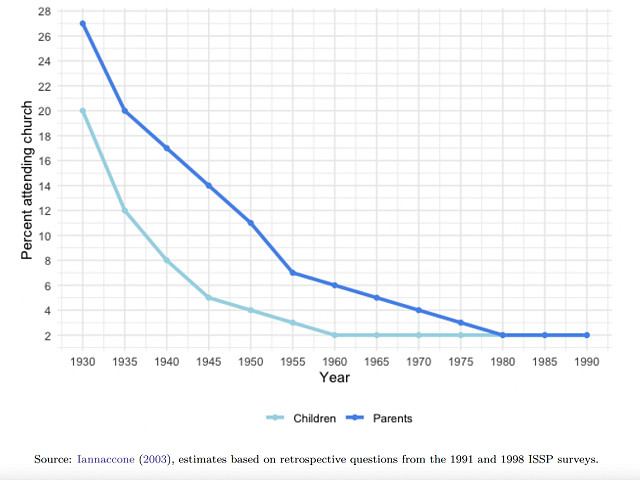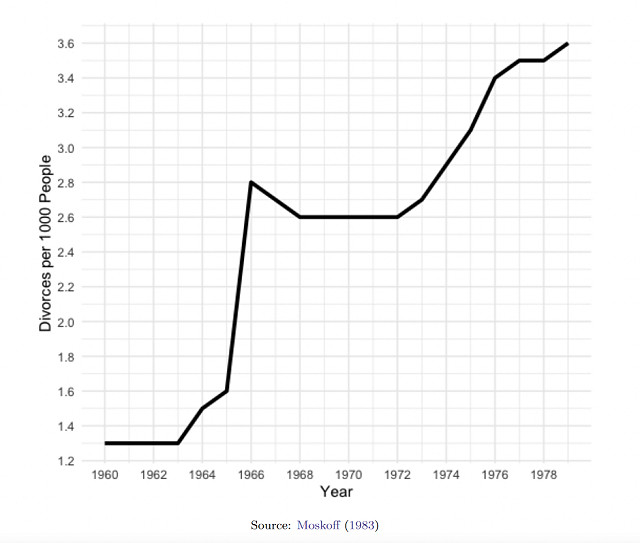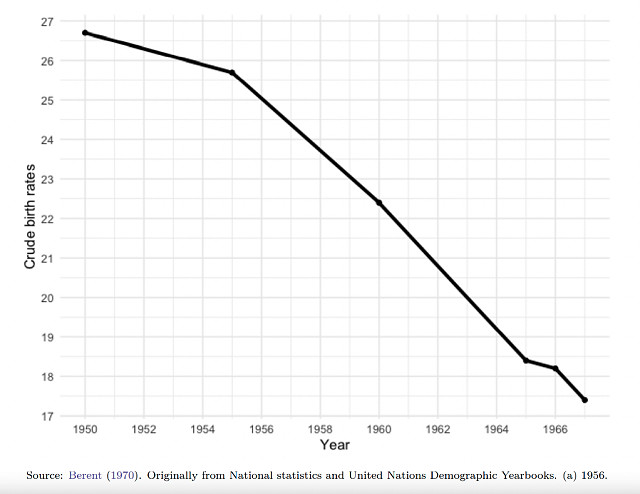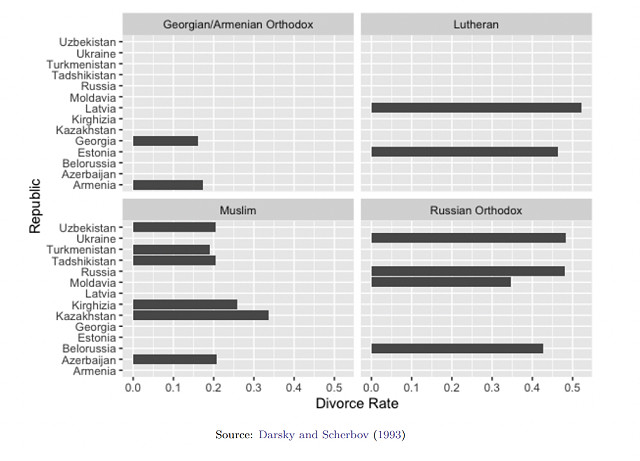_ Anna Claire Flowers, PhD fellow, Mercatus Center; graduate fellow, F.A. Hayek Program for Advanced Study in Philosophy, Politics, and Economics. Institute for Familiy Studies (IfS). Charlottsville, 25. January 2024.*
Executive summary
- An important takeaway from our study is that religion cannot be excluded from conversations about promoting marriage and family formation.
- Religion is extremely important in determining the fate of marriages.
- We demonstrate that the removal of religious authorities in the Soviet Union decreased fertility and increased divorce rates over time and within regions exposed to more religious repression.
***
Melissa Kearney’s The Two-Parent Privilege made waves amongst economists and policymakers in the final months of 2023. In podcast interviews and panel discussions, a question that consistently confronted Kearney was, “What does the decline of religion have to do with the decline of marriage?”
It was a question that Kearney said herself she wasn’t prepared to answer since the book narrowed in on the empirical relationship between unmarried parents and their children’s socioeconomic outcomes. Still, the question is a real and relevant one. What is the role of religion in supporting stable households and even, dare I say, enforcing commitment?
Clara Piano and I chip away at this question in our working paper “Three to Get Married? The Role of Religious Authorities in Marriage.” Throughout history, religious organizations have overseen the regulation and enforcement of marriage contracts, and still today religious marriage holds meaning and responsibilities distinct from marriage contracts overseen by the state alone. Isolating the effect of a marital third-party is difficult because religious couples are likely to be different on unobservable margins from those who are not. In our paper, we focus on the Soviet era, a period in which religious marriage was banned, to compare marital outcomes in cases where a religious third-party is and is not present.
Following the Bolshevik Revolution in Russia, organized religion was immediately replaced with the promotion of scientific atheism. For centuries prior to the Revolution, marriage was a religious affair, but in 1917, the Bolsheviks issued two decrees concerning marriage: first, religious ceremonies were to be replaced with civil registration, and second, unilateral divorce was now permitted. Instead of vowing their loyalty to one another under God, the bride and groom, draped in red, pledged themselves to raising the production of the state. In the next few years, the Party would further alter familial affairs by legalizing abortion, eliminating the legal category of “illegitimate child” (a label which historically encouraged monogamy and parental investment), and banning inheritance.
Figure 1. Rates of Church Attendance in Soviet Russia

Did these changes to laws and formalities alter the lived reality of married couples in the Soviet Union? Our findings suggest yes—we demonstrate that the removal of religious authorities decreased fertility and increased divorce rates both over time and within the regions of the U.S.S.R. exposed to higher degrees of religious repression. Women and children suffered; the time period immediately following the new marriage decrees are remembered as years of “postcard divorce.” The ease of divorce enabled men to change wives as they pleased, leaving abandoned women and an estimated 9 million starving children on the streets with no support. In the paper, we provide a game theory explanation of why a non-enforced marriage would lead to behavior that creates a child but discourages faithfulness.
Figure 2. Rates of Divorce in the Soviet Union

Figure 3. Crude Birth Rates in the Soviet Union

The various regions that became Soviet Socialist Republics featured different religious traditions whose involvement in marriage is visible in the data on divorce and fertility. For those in the Russian Orthodox tradition, the priest played a major role in guiding a couple through the marital covenant and its features. Though all religious organizations were targeted, the removal (and widespread execution) of Russian Orthodox priests left a gap in support and guidance for a married couple. The regions that fared best were those with Muslim heritage. Muslim SSRs had relied primarily on extended family members to enforce marital agreements for generations, so they experienced less disruption when the ban on religious marriage took effect. Divorce was lower and fertility was higher in these republics (Divorce rates shown in Figure 4).
Figure 4. Divorce Rates by Region and Religion

Economics literature frames religious organizations as firms that supply a variety of services to their members. One of these is the provision and enforcement of marital contracts. We identify at least three ways in which this occurs. First, religious intermediaries define a set of duties for each spouse that provides stability to expectations between spouses. Second, religious intermediaries provide counseling, mediation, or other services to resolve disagreements between spouses. Often, they have received training specific to these tasks which increases the value of the religious service. Finally, religious beliefs and intermediaries establish boundaries for the relationship between the couple, their families, and the broader society.
The missing piece in Soviet policy present in religious marriage was specialized third-party enforcers of the marital contract. In response to social chaos and falling birth rates that ensued after 1917, Soviet family policy shifted toward promoting fertility and discouraging divorce. Beginning in 1936 and continuing through 1944, the Party released new guidelines for marriage which increased both the monetary and time price of divorce, and attempted to encourage fertility by offering monthly allowances to women with four or more children. However, with divorce rates still above 10% in 1944, the Party was unable to achieve anything close to the marital stability exhibited by past generations of Russian Orthodox marriage or contemporaneous patterns in the Muslim Soviet Socialist Republics.
An important takeaway from this study is that religion cannot be excluded from conversations about promoting marriage and family formation. It is not surprising that divorce rates rose and fertility fell in the Soviet Union following the legalization of unilateral divorce and abortion. What does present more of a puzzle is the fact that the Soviet Union could not reverse these trends, even as legal efforts were made to incentivize staying married and having children. The difficulties faced by the state to encourage marriage and childbearing mirrors those faced by other countries with Communist histories as well as Western countries today.
In the US, while there has not been an outright attack on religion as the bedrock of social institutions such as marriage, we have experienced a clear decrease in religious involvement and widespread rejection of faith-motivated commitments to family. The drastic decline in religious involvement and marital stability and fertility among Americans mirrors the trends observed in Soviet Russia. One common denominator is fewer marriages that are enforced, supported, and guided by a religious leaders and communities.
At the top of Melissa Kearney’s list of action steps to address the problem of single-parent households is, “work to restore and foster a norm of two-parent homes for children.” Kearney means this to include a broad array of social mechanisms, including government, education, and probably religious organizations. Our findings from the Soviet-era policies suggest religious organizations and family members will play the most crucial role in the reclamation of this norm, since other mechanisms have been tried with little success. Religion is extremely important in determining the fate of marriages, and if this mechanism is abandoned, our society will be hard pressed to find a means of enforcement, motivation, guidance, and support that is comparable.
* Republished from the original publication on IfS.
